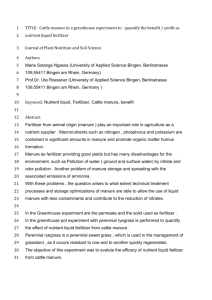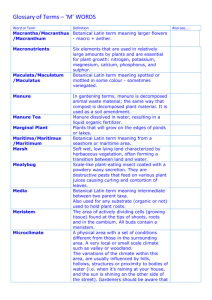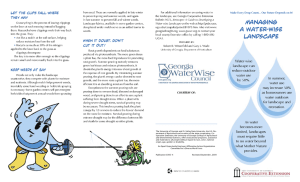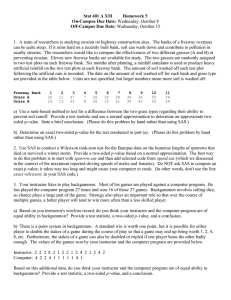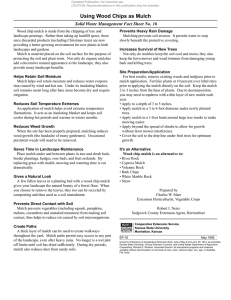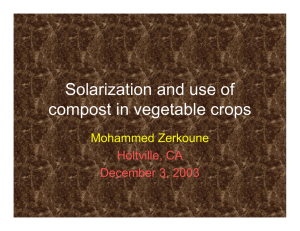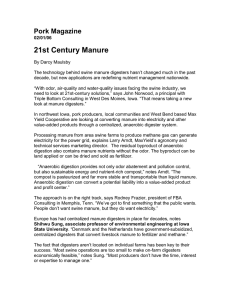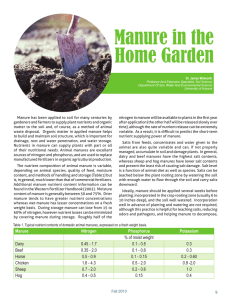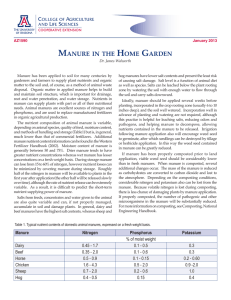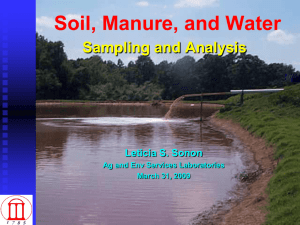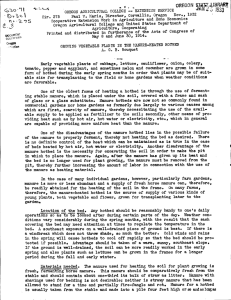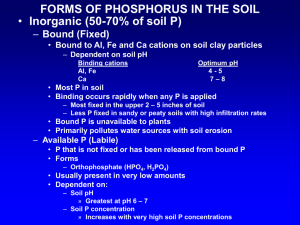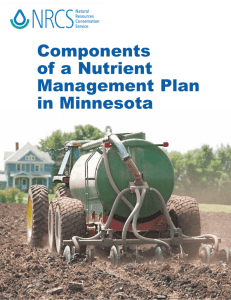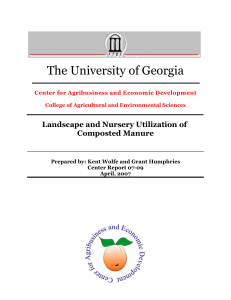Maintenance lesson
advertisement
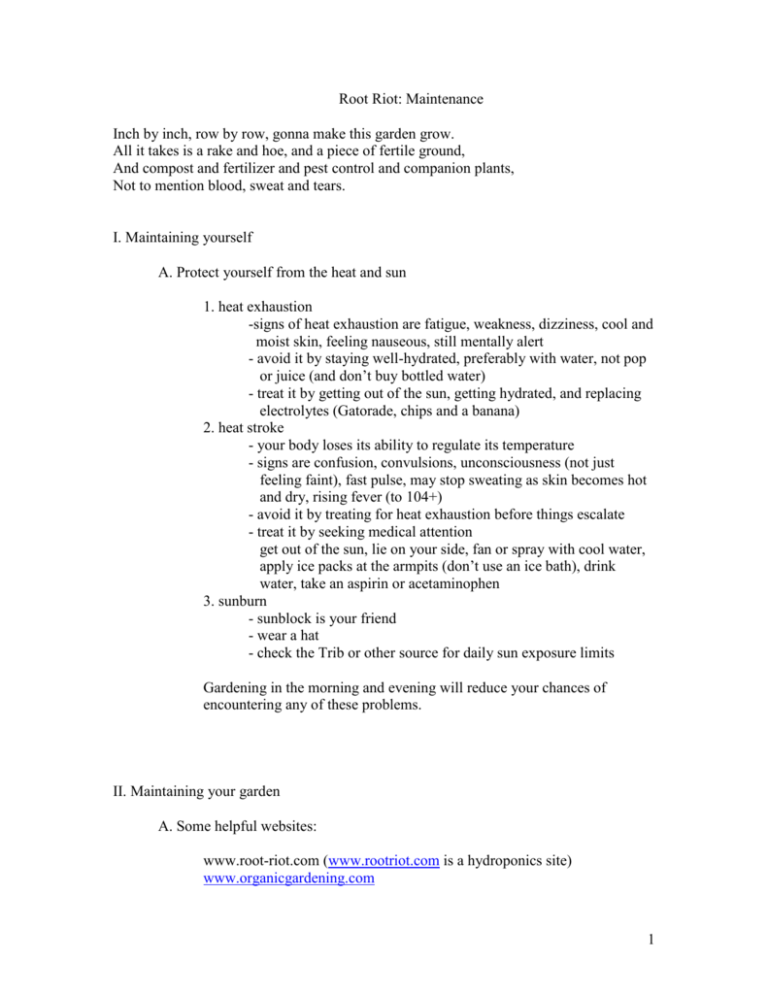
Root Riot: Maintenance Inch by inch, row by row, gonna make this garden grow. All it takes is a rake and hoe, and a piece of fertile ground, And compost and fertilizer and pest control and companion plants, Not to mention blood, sweat and tears. I. Maintaining yourself A. Protect yourself from the heat and sun 1. heat exhaustion -signs of heat exhaustion are fatigue, weakness, dizziness, cool and moist skin, feeling nauseous, still mentally alert - avoid it by staying well-hydrated, preferably with water, not pop or juice (and don’t buy bottled water) - treat it by getting out of the sun, getting hydrated, and replacing electrolytes (Gatorade, chips and a banana) 2. heat stroke - your body loses its ability to regulate its temperature - signs are confusion, convulsions, unconsciousness (not just feeling faint), fast pulse, may stop sweating as skin becomes hot and dry, rising fever (to 104+) - avoid it by treating for heat exhaustion before things escalate - treat it by seeking medical attention get out of the sun, lie on your side, fan or spray with cool water, apply ice packs at the armpits (don’t use an ice bath), drink water, take an aspirin or acetaminophen 3. sunburn - sunblock is your friend - wear a hat - check the Trib or other source for daily sun exposure limits Gardening in the morning and evening will reduce your chances of encountering any of these problems. II. Maintaining your garden A. Some helpful websites: www.root-riot.com (www.rootriot.com is a hydroponics site) www.organicgardening.com 1 B. Watering - water in the evening, if possible, or in the morning, but not at midday, so the water has time to soak in and won’t evaporate - about 1”-2” a week is good, except during hot, droughty weather, when amounts should be doubled a wilting plant is trying to conserve energy and needs water - mulch preserves water and suppresses weeds good mulch can be made from grass clippings, newspapers, or purchased - over-watering can drown the plants or leave them susceptible to problems - water the roots, not the leaves C. Use chemical free pest control 1. Weeding - weed by hand, not by herbicide once a week should be plenty use a hand trowel or rake to loosen the soil around plants 2. Pests - animal pests, like rabbits and squirrels, are hard to control if an organic repellant using pepper doesn’t work, a fence may be necessary - visual inspection for holes, cuts, white butterflies, aphids - control insect pests by hand, with neem oil, soap and water, or commercial organic preparations (peppermint, clove oil and citric acid) (concentrated fat soaps), diatomaceous earth (larger pests), B. thurigensis, ladybugs FOLLOW PACKAGE INSTRUCTIONS 3. Companion plants marigold (fragrant varieties), onion, garlic, nasturtium Remember: whatever you put on your own plot could end up on neighbor’s plot D. fertilizing - vegetables like slightly acid (sour) soil at pH 6.5-6.8 lime raises pH and adds trace elements sulfur lowers pH - good fertilizers add nitrogen and minerals like phosphorous to encourage growth formulas show N-K-P numbers: Nitrogen, Phosphorous, Potassium (potash), e.g. 5-10-10 look for deficiencies: N- pale leaves that are small and thin, purple veins, yellowing stems (lots of leaves with few blossoms indicate an excess) P – stunted growth K – stunted growth, purple tinge, small leaves 2 - worm castings, coffee grounds or slurries (a half pound in 5 gal. of water), manure (manure tea is 1/3 manure + 2/3 water stirred daily), blood meal (a quarter cup per plant), feather meal, and eggshells are all excellent, or read up on organic plant care good commercial natural fertilizers are made from plant and animal material that becomes part of the soil and don’t have to be applied very often a couple home-made recipes: 2-5-2 4-5-4 2 parts coffee grounds 2 parts dried blood 1 part manure 1 part phosphate rock 1 part bone meal 4 parts wood ash - over-fertilizing only encourages the plant to use too much energy growing and can burn the plant - leaf mulch uses energy and binds nutrients in the soil - measurements lime – 2.5lbs/100sq ft a commercial 5-10-10 fertilizer 0.5 Tbs/plant - or 2 handfuls of manure generally, 1lb = 1 pint (2 cups), 1 cup/ sq ft or 2 Tbs/plant use when flowers or heads form E. Succession planting - plant dissimilar succession crops - map your garden now - get late crops in 8-10 weeks before the first frost (by Aug.9) A few words about tomatoes Leaf mulch is likely acidic and binds nutrients, which will stunt growth and cause deficiency problems. If it is wet, it can lead to damping off from fungi. Correct by amending the mulch with clean soil and fully composted material. Add manure at 1 lb/ sq ft. (fresh manure doesn’t make good fertilizer) Prune suckers so energy goes into fruit production. Water only wilting plants so that roots grow and spread. Hay mulch retains water best. Dark green, vigorous plants don’t need extra water or fertilizer. Yellow, pale green plants can be side-dressed Signs of trouble – verticilium or fusarium rot; blossom end rot; mottling, curly leaves, and stunting; blight, spots, or rot 3



